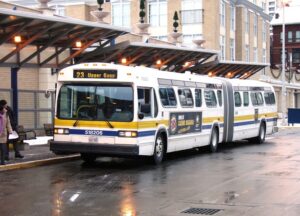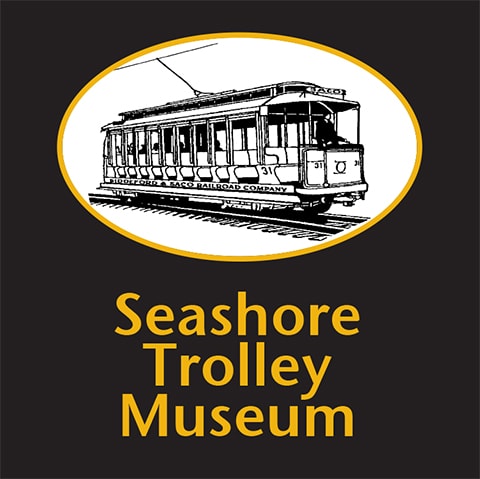
No. 518203 in service, 2007; STM collection.
Operating History: In 1982, the Ontario government undertook a demonstration project to test higher capacity, articulated buses in four Ontario cities: Hamilton, Ottawa, Toronto and Mississauga. General Motors of Canada Diesel Division built 53 of these buses. Ontario’s articulated buses were 60 feet long and could bend in the middle, compared with standard buses which are up to 40 feet long. Prior to this project, articulated buses in the United States and Canada were unusual. Seashore also has an articulated bus from a small fleet in Omaha produced in 1947, and some U.S. cities imported articulated buses from Europe in the late 1970s. Most of the European articulated buses were “pullers” with the engine in the front section. The GM buses for Ontario were “pushers” with the engine in the rear, similar to most other non-articulated buses of the time. The rear engine required extra engineering because the majority of the weight was at the rear of the vehicle making it prone to jack-knifing. So, the articulated joint in the GM buses had anti-jack-knifing force and would lock up when the coach reached certain speeds to increase stability.
Of the 53 articulated buses, six went to the Hamilton Street Railway (HSR) and were numbered 8201-8206. HSR is the city-owned operator of the transit system in Hamilton, Ontario. The corporate name dates to the horse car era in 1873 and has been retained long after HSR abandoned streetcars in 1951. After a three year trial, Toronto and Ottawa decided not to keep their articulated buses which were then distributed to Hamilton and Mississauga with Hamilton receiving nine from Ottawa. Hamilton’s articulated buses originally had a yellow and black paint scheme inspired by the colors of the Hamilton Tigercats team in the Canadian Football League. In 2001, No. 8203 was renumbered to 518203. The bus also received a white paint scheme with yellow and blue stripes. The high capacity articulated buses commonly ran on the route linking McMaster University with downtown. In 2007, No. 518203 was the last of the 53 articulated buses to be retired. That year, HSR began operating new, hybrid diesel electric articulated buses.
Museum Ownership: Hamilton Street Railway donated No. 51823 to Seashore in 2009. A Seashore crew made repairs to the bus and, in a four-day trip, drove it to Kennebunkport. At Seashore, No. 518203 joined one other articulated bus: Omaha No. 1312. The Omaha bus, built in 1947, bends only vertically so that all wheels stay on the ground while climbing hills, unlike the Hamilton bus which bends horizontally. No. 518203 became part of the museum’s extensive collection of Canadian transit vehicles – the largest outside of Canada. The bus has operated around the museum and off site.
Current Condition: No. 518203 is stored outside the Highwood Carhouse.
 |
 |
 |
